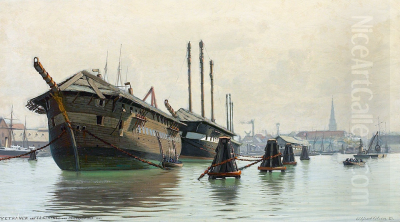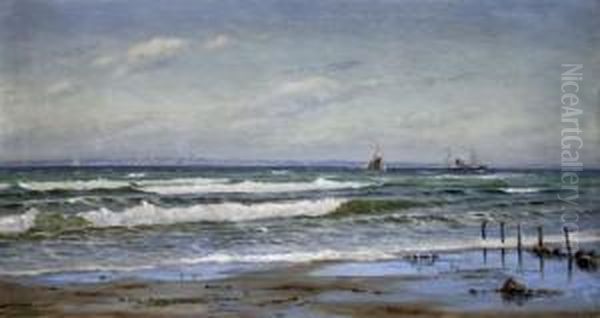
Alfred Olsen (1854-1932) was a Danish painter who dedicated much of his artistic career to capturing the unique landscapes and maritime life of Denmark, particularly the coastal regions of West Jutland. Working during a vibrant period in Scandinavian art, Olsen developed a distinctive style characterized by his keen observation of atmospheric conditions and his ability to convey the interplay of light, weather, and the sea. Though perhaps not as internationally renowned as some of his contemporaries, his work offers a valuable window into the Danish artistic traditions of the late 19th and early 20th centuries, particularly in the realm of marine and landscape painting.
Early Life and Artistic Beginnings
Born in 1854 on the small Danish island of Fejø, Alfred Olsen's early life would have been intrinsically linked to the sea and the rhythms of coastal existence. This formative environment likely instilled in him a deep appreciation for the natural world, an appreciation that would later become a cornerstone of his artistic output. While details of his earliest education are not extensively documented, a significant step in his artistic journey occurred in 1876.
In that year, Olsen moved to Copenhagen, the bustling capital of Denmark and the center of its artistic and cultural life. There, he sought formal training to hone his burgeoning talent. He began studying painting under the tutelage of Jens Jensen-Egeberg (1848-1922). Jensen-Egeberg was an established artist known for his landscape paintings, and his guidance would have provided Olsen with a solid foundation in the techniques of oil painting, composition, and the principles of depicting nature. This period of study was crucial, as it exposed Olsen to the prevailing artistic currents and academic standards of the time, while also allowing him to develop his own observational skills.
A Career in Marine Painting
Following his studies with Jensen-Egeberg, Alfred Olsen established himself as a professional painter in Copenhagen. He soon gravitated towards marine painting, a genre with a rich history in Denmark, a nation with an extensive coastline and a strong seafaring tradition. His chosen specialty became the depiction of the coasts of West Jutland, a region known for its dramatic scenery, wide skies, and often tempestuous weather.

Olsen's approach to marine painting was marked by a profound sensitivity to the nuances of the environment. His works are noted for their careful attention to the changing effects of weather, the quality of light at different times of day, and the vastness of the sky, which often occupied a significant portion of his canvases—a common compositional choice in marine art that emphasizes the power and scale of nature. He aimed to capture not just the visual appearance of the coast, but also its atmosphere and the feeling of being present in these often-harsh, yet beautiful, landscapes.
His paintings frequently featured elements characteristic of the Jutland coast: expansive beaches, rolling dunes, the ever-present sea, and the distinctive forms of windmills, which were vital to the local economy and life. These windmills, silhouetted against the sky or standing as sturdy sentinels in the landscape, often add a human element to his scenes, suggesting the close relationship between the people of Jutland and their natural surroundings. Sailing ships, fishing boats, and other maritime vessels also populated his canvases, reflecting the daily life and commerce of the coastal communities.
Artistic Style and Influences
Alfred Olsen's artistic style can be situated within the broader trends of late 19th-century European painting, which saw a continued interest in Realism and Naturalism, as well as the emergence of Impressionistic influences in capturing light and atmosphere. While not strictly an Impressionist, Olsen's focus on the transient effects of light and weather shares some common ground with the Impressionist sensibility. His work demonstrates a flexible approach to color and brushwork, adapting his technique to convey the specific conditions of a scene—be it the bright clarity of a summer day, the muted tones of an overcast sky, or the dramatic light of a storm.
The Danish art scene during Olsen's formative and active years was dynamic. The legacy of the Danish Golden Age painters, such as Christoffer Wilhelm Eckersberg (1783-1853), Christen Købke (1810-1848), and Johan Thomas Lundbye (1818-1848), had established a strong tradition of landscape and genre painting characterized by meticulous observation and a poetic sense of realism. While Olsen's generation moved beyond the specific aesthetics of the Golden Age, the emphasis on direct study from nature remained a powerful influence.
A particularly significant contemporary movement was the Skagen Painters, a colony of artists who gathered in the northernmost part of Jutland from the 1870s onwards. Figures like Michael Ancher (1849-1927), Anna Ancher (1859-1935), P.S. Krøyer (1851-1909), and the marine specialist Carl Locher (1851-1915) were drawn to Skagen's unique light and coastal scenery. They embraced plein air (outdoor) painting and sought to capture the everyday lives of the local fishing communities with a fresh, naturalistic approach. Alfred Olsen, with his focus on the Jutland coast and his sensitivity to light, undoubtedly worked within a similar artistic spirit, even if he was not formally part of the Skagen group. His depictions of Skagen itself suggest an engagement with the same landscapes that captivated these renowned artists.
Other notable Danish artists of the period whose work provides context for Olsen's include Vilhelm Hammershøi (1864-1916), known for his quiet, enigmatic interiors and cityscapes, and L.A. Ring (1854-1933), a contemporary of Olsen's who depicted rural life and landscapes with a symbolic and socially conscious realism. Theodor Philipsen (1840-1920) was another important figure, often considered one of Denmark's foremost Impressionists, particularly known for his depictions of animals and landscapes. The Fynboerne (Funen Painters), including artists like Peter Hansen (1868-1928), Fritz Syberg (1862-1939), and Johannes Larsen (1867-1961), were another contemporary group focused on depicting the landscapes and rural life of the island of Funen. While Olsen's primary focus was the Jutland coast, the broader artistic environment was rich with painters exploring different facets of Danish nature and society.
Representative Works and Themes
Among Alfred Olsen's known works, "Shipping along the Coast" stands out as a representative example of his marine painting. While specific details of this particular piece might vary across different attributions, paintings with such titles typically showcase his skill in rendering the sea, sky, and sailing vessels. These works often convey a sense of movement and the dynamic relationship between human endeavor and the forces of nature. The ships, whether fishing boats or larger merchant vessels, are depicted with an understanding of their structure and their interaction with wind and water. The coastline itself, whether a sandy beach or a more rugged shore, provides the grounding element, linking the vastness of the sea to the specificity of the Danish landscape.
Another notable, though perhaps generically described, aspect of his oeuvre includes panoramic coastal scenes from the Skagen area. These paintings are characterized by their depiction of sand dunes, inland pools, and the tranquil, yet powerful, natural world of Denmark's northern tip. A key feature in these works is the emphasis on light and serenity, capturing the unique atmospheric qualities that drew so many artists to Skagen. Olsen's ability to render the subtle gradations of color in the sky and water, and the way light falls upon the landscape, would have been central to the success of these compositions.
The recurring themes in Olsen's work are deeply tied to his chosen subject matter. The sea, in its many moods, is a dominant presence—sometimes calm and reflective, other times choppy and windswept. The sky, as mentioned, plays a crucial role, often dictating the overall atmosphere of the painting. His interest in the effects of weather is evident, with paintings likely capturing the clear light after a storm, the hazy conditions of a misty morning, or the dramatic cloud formations preceding a squall. The human element, represented by ships, windmills, and occasionally figures, speaks to the resilience and adaptability of life in these coastal environments.
Olsen's Place in Danish Art History
Alfred Olsen can be seen as a dedicated practitioner of marine and coastal landscape painting within the Danish tradition. He operated during a period when Danish art was diversifying, with artists exploring various stylistic paths, from continued realism to impressionistic experiments and burgeoning symbolism. Olsen's work appears to align most closely with the realistic and naturalistic traditions, emphasizing faithful observation and a deep connection to the specific character of the Danish landscape.
His teacher, Jens Jensen-Egeberg, was himself a landscape painter, and it is plausible that Olsen's career trajectory might have involved some level of collegial interaction or even friendly competition with his former mentor or other marine painters of the era. The art scene in Copenhagen, while perhaps not as large as Paris or Berlin, would have fostered a community where artists were aware of each other's work, exhibiting in similar venues and responding to shared artistic concerns.
While he may not have achieved the same level of fame as the leading figures of the Skagen School or innovators like Hammershøi, Olsen's contribution lies in his consistent and sensitive portrayal of a particular aspect of Danish identity: its relationship with the sea. Artists like Olsen, who specialize in a specific genre or region, play an important role in creating a comprehensive visual record of their nation's heritage and environment. His paintings of the West Jutland coast contribute to this broader tapestry of Danish art, offering a personal vision of landscapes that are central to the country's geography and culture.
The fact that many of his works are reported to be in private collections, rather than widely displayed in public museums, might contribute to his relatively modest public profile today. However, this does not diminish the intrinsic artistic merit of his work or its value as a historical and cultural document. For collectors and enthusiasts of Danish art, particularly marine painting, Olsen's works would be appreciated for their authenticity and their evocative portrayal of the coastal environment.
Later Life and Legacy
Alfred Olsen continued to paint throughout his life, remaining dedicated to his chosen subjects. He passed away in 1932 at the age of 78. His legacy is that of an artist who found his inspiration in the natural beauty and maritime life of his homeland. He was part of a generation of Danish painters who, following the Golden Age, sought to interpret the Danish landscape and its inhabitants with honesty and skill, each contributing their unique perspective.
His paintings serve as a reminder of the enduring appeal of the sea as an artistic subject and the importance of regional schools and specialized painters in capturing the diverse character of a nation. While the grand narratives of art history often focus on major movements and groundbreaking innovators, the work of artists like Alfred Olsen provides depth and texture to our understanding of a particular time and place. His depictions of the Jutland coast, with their attention to light, atmosphere, and the details of maritime life, offer a quiet but persistent voice in the chorus of Danish art.
In conclusion, Alfred Olsen was a skilled Danish painter whose life and work were intimately connected with the sea and coasts of Denmark. His studies under Jens Jensen-Egeberg provided him with a strong technical foundation, which he applied to a career focused on marine and landscape art, particularly the evocative scenery of West Jutland and Skagen. Working in an era that included prominent figures like P.S. Krøyer, Michael Ancher, and L.A. Ring, Olsen carved out his niche, contributing to the rich tradition of Danish naturalism. His paintings, characterized by their sensitivity to atmospheric conditions and their faithful representation of coastal life, remain a testament to his dedication and his deep appreciation for the Danish environment. Though perhaps less celebrated than some of his contemporaries, Alfred Olsen's art endures as a valuable part of Denmark's artistic heritage.